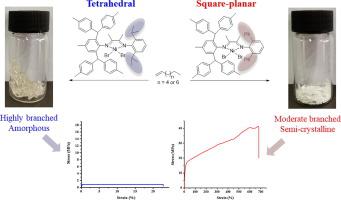Journal of Catalysis ( IF 7.3 ) Pub Date : 2022-06-02 , DOI: 10.1016/j.jcat.2022.05.020 Lihua Guo , Weiqiang Chen , Wanjuan Wang , Wenyu An , Shengnan Gao , Yang Zhao , Mingling Luo , Guoshan He , Tongtong Liu

|
The tuning of polyolefin microstructure, including the branching density and branching distribution, through the ligand modification in transition metal-based catalysts has received considerable interest. In this work, we present the synthesis and characterization of a series of α-diimine Ni(II) catalysts containing bulky diarylmethyl moiety and varied steric substituents, and a systematic investigation on the catalytic behavior of these catalyst for 1-octene and 1-decene polymerization. Ni3 with ortho-diisopropyl substituents adopts a common distorted tetrahedral geometry, while a rare square planar geometry is observed for Ni4 with ortho-phenyl substituents. The ortho-substituent effect on the preference of insertion fashion (1,2 or 2,1-insertion) and chain-walking in long chain α-olefin polymerization is also established. Highly branched amorphous polyolefin can be obtained by the unsymmetrical catalyst with ortho-alkyl substituents (H, Me, iPr) in which the major 1,2-insetion pathway was observed, whereas moderate branched semicrystalline polyolefin can be produced by the unsymmetrical catalyst with ortho-phenyl substituents, which showed a significant increase in 2,1-insertion. Most interestingly, the branching distribution analysis through 13C NMR indicated that the polymer obtained by Ni3 gave the higher percentage of long-chain branches relative to methyl branches, while Ni4 afforded the polymer with methyl branches being predominant. These significant differences in coordination geometry and catalytic behavior between Ni3 and Ni4 may be associated with the unique steric congestion of the ortho-phenyl substituents. In particular, the comparative investigation of the mechanical properties of the polymers obtained by Ni3 and Ni4 was also performed.
中文翻译:

α-二亚胺镍催化长链α-烯烃聚合中邻位取代基对金属配位几何结构、链微观结构和聚合物性能的影响
通过过渡金属基催化剂中的配体改性来调节聚烯烃微观结构,包括支化密度和支化分布,引起了相当大的兴趣。在这项工作中,我们介绍了一系列含有庞大二芳基甲基部分和各种空间取代基的 α-二亚胺 Ni(II) 催化剂的合成和表征,并系统地研究了这些催化剂对 1-辛烯和 1-癸烯的催化行为聚合。具有邻二异丙基取代基的Ni3采用常见的扭曲四面体几何形状,而具有邻苯基取代基的Ni4则观察到罕见的方形平面几何形状。邻位-取代基对插入方式(1,2 或 2,1-插入)的偏好和长链 α-烯烃聚合中的链行走的影响也得到了证实。高度支化的无定形聚烯烃可以通过具有邻位烷基取代基(H、Me、iPr)的不对称催化剂获得,其中观察到主要的 1,2-插入途径,而中等支化的半结晶聚烯烃可以通过具有邻位烷基取代基的不对称催化剂制备。 -苯基取代基,这表明2,1-插入显着增加。最有趣的是,通过13 C NMR 进行的支化分布分析表明,由Ni3获得的聚合物的长链支链相对于甲基支链的百分比更高,而Ni4得到以甲基支链为主的聚合物。Ni3和Ni4之间配位几何和催化行为的这些显着差异可能与邻苯取代基独特的空间拥挤有关。特别是对Ni3和Ni4得到的聚合物的力学性能进行了比较研究。



























 京公网安备 11010802027423号
京公网安备 11010802027423号